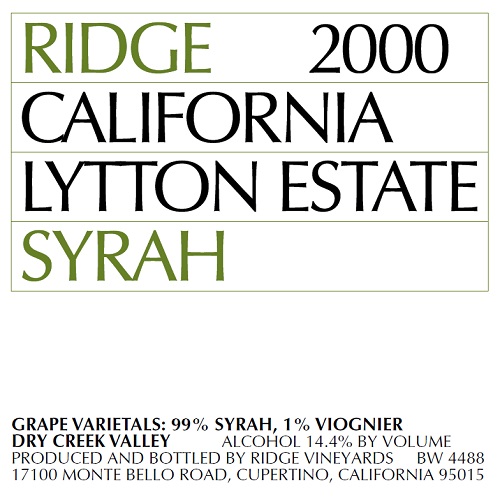
2000 Lytton Estate Syrah
Wine Information
99% Syrah, 1% Viognier
Vintage
2000
Vineyard
Lytton Springs
Appellation
Dry Creek Valley
Alcohol By Volume
14.4%
Winemaker Tasting Notes
Pungent boysenberry, black raspberry jam, integrated oak. Powerful, ripe focused flavors. Abundant tannins. Excellent aging potential.
Vintage Notes
This year, the three syrah parcels on the hillsides at Lytton West set an excellent crop, and were rigorously thinned. The grapes were destemmed, but not crushed, to moderate extraction of seed tannin while accentuating fruit. Fermentation was natural and the cap of skins allowed to float; juice was gently circulated once a day. The wine fermented to dryness in eight days, and the skins were pressed immediately to avoid excessive tannin. A natural malolactic was completed in barrel. For the first time, the younger vines were included in the final wine, which was aged in air-dried american oak for eighteen months. The intense fruit of this rich, complex syrah is beautifully balanced by firm, round tannins. Approachable now, it will soften and continue to develop with five to ten years of bottle age. PD (4/02)
History
Syrah cuttings were first brought to California from France’s Rhône Valley in the 1870s. Though not extensively planted, a number of syrah vineyards were established, and it was interplanted with zinfandel. In the 1870s and ’80s, virtually all California’s vineyards—including the syrah—were destroyed by phylloxera. When growers replanted on resistant rootstock, syrah was not among the varietals chosen. Zinfandel, dominant in all the better California red wines, was the most extensively planted varietal from the 1860s to the 1990s. We speculate that growers were looking for grapes that could complement zinfandel in a blend—not grapes that could stand alone as distinct varietal wines. Syrah—not the easiest grape to grow—did not complement it as well as petite sirah (syrah crossed with peloursin), which had arrived from southern France in the 1880s. To our knowledge, only one truly old syrah planting (1915-1920) has survived. That vineyard also includes rows of petite sirah—even some peloursin. There are a few scattered syrah vines in old zinfandel vineyards, but petite sirah and carignane are far more common. The hundred-year old blocks at Lytton Springs and Geyserville’s hundred-twenty-year-old “Old Patch” each have the occasional syrah vine.
The re-introduction of syrah can be traced to cuttings of two clones imported in 1936 by Professor Harold Olmo of the University of
California at Davis. They were the source of the Christian Brothers Napa planting in the 1960s, and went from there to Phelps. One of those two clones, available from the Davis Collection, became known as “syrah noir.” When Ridge purchased the western half of Lytton Springs in the mid-1990s, it included a few acres of mature syrah noir vines and a small block of viognier. These provided our first ATP syrah, in 1996. In the last twenty years, several selections from the Rhône have been hand-carried into California, and a good number of certified syrah clones from French government nurseries are now available here. Convinced of the quality of syrah grown at Lytton Springs, we have planted a number of different clones in several more small parcels.
Growing Season
Rainfall: Over 40 inches (normal for this area)
Bloom: May (normal)
Weather: Warm spring and summer. Several heat spikes in late summer/early fall accelerated harvest.
Winemaking
42 barrels produced
Harvest Dates: 16 September – 21 September
Grapes: Average brix 25.4°; average pH at crush 3.66. The three syrah blocks ripened within one week of each other.
Fermentation: Destemmed, but not crushed. Fermented with indigenous yeast (no inoculation). Pressed after eight days.
Barrels: 100% air-dried american oak barrels (13% new, 17% one year old, 18% two, 45% three, and 7% four years old).
Aging: Eighteen months in barrel
Consumer Tasting Notes
Average Rating: 90.6
No. of Tasting Notes: 23
View this wine on CellarTracker
Food Pairings
See all food pairing recipes we have created specifically for this wine.
See pairingsWait!
In order to qualify for user related discounts, you must log in before proceeding with checkout. Click the button below to log in and receive these benefits, or close the window to continue.
Log In